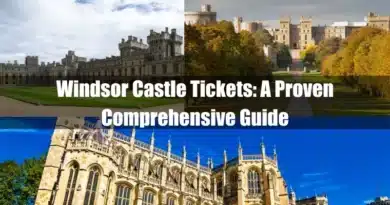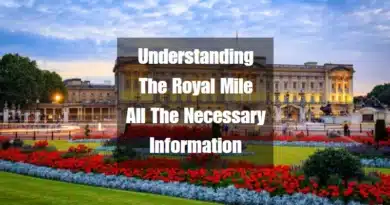Buckingham Palace is a grand London landmark with a grand facade – creamy white stone in a classical style with wrought iron gates and balconies. Inside are 775 rooms, including lavish State Rooms used for entertaining dignitaries, all decorated in various styles from grand gold and red to Chinese regency. The palace also boasts extensive gardens, the largest private garden in London.
This article will explore Buckingham Palace’s appearance, including its architectural features, interior design, and surrounding grounds.
I. Architecture and Exterior Features of Buckingham Palace
The palace serves as the official residence of the British monarch and has been the focus of numerous ceremonies, state visits, and royal events. Here are some of the critical features and architectural highlights of Buckingham Palace:
A. Neoclassical Architecture
- Architects built Buckingham Palace in a neoclassical style, which gained popularity during the 18th and 19th centuries.
- John Nash, an English architect, designed the palace in 1826.
B. The Main Facade
- The main facade of Buckingham Palace faces The Mall and is 108 meters (354 feet) long.
- The facade features 19 state rooms used for official receptions and state functions.
C. The Balcony of Buckingham Palace
- Members of the royal family appear on the famous balcony at Buckingham Palace during public events, such as Trooping the Colour.
- The balcony was added to the palace in 1850 by Queen Victoria.
D. The Gardens
- The palace surrounds 40 acres of gardens that comprise a lake, a tennis court, and a helicopter landing area.
- The gardens are home to over 350 types of wildflowers and over 200 trees.
E. The Victoria Memorial
- They erected the Victoria Memorial in front of Buckingham Palace as a monument in memory of Queen Victoria.
- The monument features a statue of Queen Victoria surrounded by allegorical figures representing Truth, Justice, and Charity.
F. The East Front
- The Changing of the Guard ceremony occurs on the East Front of Buckingham Palace.
- The facade features a grand entrance known as the Grand Entrance or the Ambassadors’ Entrance.
G. The West Front
- The West Front of Buckingham Palace is the private entrance for royal family members.
- The facade features a large balcony that overlooks the gardens.
Buckingham Palace is an essential landmark of London and a symbol of the British monarchy. Its neoclassical architecture, magnificent facades, and beautiful gardens attract millions of visitors annually.
II. Interior Design of Buckingham Palace
Buckingham Palace, the British monarch’s official residence in London, is an iconic example of classic interior design that has evolved over centuries. Here are some of the features and design elements of the palace’s interior:
A. Entrance Hall
- Features marble columns and a grand staircase
- It contains busts and statues of historical figures
B. State Rooms
- Includes the White Drawing Room, Green Drawing Room, Throne Room, and Music Room
- Decorated with ornate furniture, chandeliers, and artwork
- Walls adorned with historical paintings and tapestries
C. Royal Bedrooms
- It contains several bedrooms, including the Queen’s private bedroom
- Features luxurious furnishings, including four-poster beds and silk curtains
D. Dining Rooms
- Includes the State Dining Room and the smaller, more intimate Blue Drawing Room
- Furnished with lavish tables, chairs, and tableware
E. Chinese Dining Room
- The Chinese Dining Room is used for formal state banquets and features a collection of Chinese porcelain and furniture.
- The decorator adorned the room with Chinese decor, red lacquer walls and a ceiling embellished with a dragon motif.
F. The Ballroom
- Considered the grandest room in Buckingham Palace
- Can accommodate up to 500 guests for official events
- Decorated with gold leaf and chandeliers
G. Grand Staircase
- The Grand Staircase is one of the palace’s most impressive interior design features.
- Portland stone makes up the staircase, which features bronze balustrades.
- Artist John Alexander adorns the ceiling with a stunning fresco.
H. Throne Room
- The royal family uses the Throne Room for ceremonial occasions, making it one of the most critical rooms in the palace.
- The room features a magnificent throne made of gold and velvet.
- Rich red silk damask covers the walls, and a chandelier adorns the ceiling.
Also, read 25 Best Historical Places to Visit in the UK.
I. Picture Gallery
- The Picture Gallery is the largest room in the palace and is used to display some of the royal family’s art collections.
- The room features work by artists like Rembrandt, Rubens, and Vermeer.
- Red silk damask covers the walls, and chandeliers illuminate the room.
J. Blue Drawing Room
- The Blue Drawing Room is named after its blue walls and features a collection of 18th-century porcelain and furniture.
- Royal family often use the room for small meetings and receptions.
K. White Drawing Room
- The White Drawing Room is one of the palace’s most popular rooms, and it is used for official receptions.
- The room boasts a collection of 18th-century French furniture and a stunning chandelier.
- White silk damask covers the walls, giving the room its name.
L. The Royal Mews
- It contains the royal collection of coaches and carriages
- Features state coaches used in coronations and other royal events
Overall, the interior design of Buckingham Palace is a beautiful blend of classic and contemporary styles that reflects the grandeur and prestige of the British monarchy.
Also, check out Unveiling London’s Secrets: A Guide to 20 Hidden Gems.
III. Surrounding Grounds of Buckingham Palace
Its surrounding grounds are well-known for their beauty and historical significance. Here are some key features and points of interest:
A. The Memorial Gardens
The late Diana Princess of Wales inspired the creation of the Memorial Gardens, which honour her legacy. The public can visit the garden on the palace’s west side during the summer.
B. The Palace Gates
The iconic Buckingham Palace Guards guard the Palace Gates at the front of Buckingham Palace. The gates are also a popular spot for tourists to take pictures.
C. The Changing of the Guard
The Changing of the Guard is a famous ceremony at Buckingham Palace. The ceremony involves changing the guards outside the palace gates and is a must-see for tourists.
D. The Palace Gardens
- The palace gardens cover an area of 39 acres.
- The gardens were initially laid out in the 1820s by George IV.
- Visitors can explore the gardens during the summer when they are open to the public.
- The gardens feature a lake, a tennis court, and a helicopter landing area.
E. The Victoria Memorial
- The Victoria Memorial is in front of the palace and is one of London’s most iconic landmarks.
- Royal Family unveiled the memorial in 1911 to remember Queen Victoria.
- The monument is constructed of white marble and features a gilded statue of Victoria.
F. The Palace Courtyard
- The Palace Courtyard is the central square in front of Buckingham Palace.
- The royal family and guests utilise the courtyard for ceremonial events, including Changing the Guard.
- Visitors may see the Changing of the Guard event outside the palace gates.
G. The Mall
- The Mall is a grand ceremonial avenue that connects Trafalgar Square to Buckingham Palace.
- The road is lined with trees and leads directly to the palace gates.
- People often use The Mall for processions and parades.
Overall, the surrounding grounds of Buckingham Palace are a beautiful and historic destination in London. Visitors can explore the palace gardens, see the Victoria Memorial, tour the Royal Mews, watch the Changing of the Guard ceremony, and stroll along the grand Mall.
IV. Take Away
In conclusion, Buckingham Palace is an iconic symbol of the British monarchy and an architectural masterpiece. The neoclassical style dominates the palace’s exterior, with grand entrances and balconies adorned with intricate carvings and sculptures. The palace interior boasts exquisite art collections, opulent furnishings, and ornate decorations, reflecting the grandeur of the royal family.
The palace’s surrounding grounds are just as impressive, with sprawling gardens and lawns, a picturesque lake, and the famous Buckingham Palace balcony, where the royal family makes public appearances.
While Buckingham Palace serves as a residence and a working palace for the royal family, it also attracts Millions of tourists each year to marvel at its majesty and learn about the rich history and culture of the British monarchy. Overall, Buckingham Palace remains a must-see destination for anyone interested in architecture, history, and royal culture.









Comments are closed.